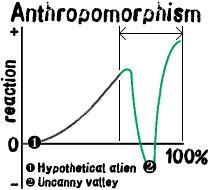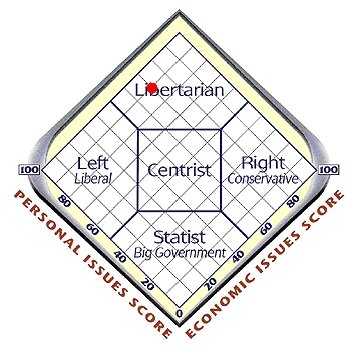

Because I can NEVER remember this phrase.....
The Uncanny Valley
Why are monster-movie zombies so horrifying
and talking animals so fascinating?
Written and illustrated by Dave Bryant
Japanese roboticist Doctor Masahiro Mori is not exactly a household name—but, for the speculative fiction community at least, he could prove to be an important one. The reason why can be summed up in a simple, strangely elegant phrase that translates into English as “the uncanny valley”.
Though originally intended to provide an insight into human psychological reaction to robotic design, the concept expressed by this phrase is equally applicable to interactions with nearly any nonhuman entity. Stated simply, the idea is that if one were to plot emotional response against similarity to human appearance and movement, the curve is not a sure, steady upward trend. Instead, there is a peak shortly before one reaches a completely human “look” . . . but then a deep chasm plunges below neutrality into a strongly negative response before rebounding to a second peak where resemblance to humanity is complete.
This chasm—the uncanny valley of Doctor Mori’s thesis—represents the point at which a person observing the creature or object in question sees something that is nearly human, but just enough off-kilter to seem eerie or disquieting. The first peak, moreover, is where that same individual would see something that is human enough to arouse some empathy, yet at the same time is clearly enough not human to avoid the sense of wrongness. The slope leading up to this first peak is a province of relative emotional detachment—affection, perhaps, but rarely more than that.
The figure to the right diagrams this curve of emotional response, plotting it (from top to bottom) first against how closely an entity’s motion resembles human movement, then against physical resemblance to human appearance, and last against a synthesis of the two. It is significant to note, judging from the relative depth of the curves, that Dr. Mori apparently considers motion more important than simple appearance, though he stresses that both are affected at least as much by subtle nuances as by more striking factors.
The conclusion drawn by the good doctor is that designers of robots or prosthetics should not strive overly hard to duplicate human appearance, lest some seemingly minor flaw drop the hapless android or cyborg into the uncanny valley—a fate to be dreaded by all concerned. He maintains instead that a prosthesis or a robot should be visibly artificial, but smart and stylish in appearance, placing it somewhere near the top of the first peak. This ethos, incidentally, can be seen clearly in a great many science fiction and fantasy manga and animé stories.
The same factors that inspired Doctor Mori to research and describe the uncanny valley and the rest of the curve to which it belongs are of immediate concern to any creator of fantasy or science fiction. Aside from the readily apparent potential for careful tailoring of a character’s or species’ “look and feel” to evoke a specific reaction from the audience, there are some perhaps surprising possibilities and consequences.
Here Be Dragons
In reality, it seems likely that alien sophonts are so completely unlike humans or other terrestrial life that communication or any kind of empathy, possibly even recognition of the aliens as intelligent beings, would be difficult at best. Such a case falls very low on the initial slope at the left of each of the charts in the figure above. Bafflement might well be the dominant human reaction: the sort of mental confusion that results when one looks at something one knows is there but can’t quite make out, like a camouflaged figure against a wooded background or an unexpected optical illusion. Even becoming accustomed to the presence of such aliens might not improve matters significantly, other than to inure humans to the idea that they are outside the bounds of comprehension.
Of course, fiction and art are created by humans for human audiences. While enigmatic alien life or ineffable elder deities have their place in such works, for the most part it is necessary, and easier, to create fictitious creatures with at least some vague kinship to man—a concept familiar to readers of this magazine as anthropomorphism. Perhaps not surprisingly, the realm of the anthropomorphic character stretches from near the height of the first peak, through the uncanny valley, to the final peak at the right of the curve, as seen in the figure to the right. It is here that the overwhelming majority of characters fit, whether from the earliest campfire tales and cave drawings or the latest Web archives.
A closer examination of this section of the curve reveals four distinct regions of interest. From right to left, they are the steep slope falling off from the final peak, the uncanny valley itself, the corresponding steep slope on the valley’s other side, and the rounded peak linking that slope to the more gradual one at the left of the chart.
The rightmost slope is where every member of the human species can be placed, as well as those fictitious beings similar enough to humans to be mistaken for them under less than ideal viewing conditions. At the top of the slope would be any healthy, normal-looking person; at the bottom, perhaps even in the uncanny valley itself, might be the profoundly disfigured or deformed, such as John Merrick, the so-called “Elephant Man”. Between these extremes one could place an ill but otherwise normal person (near the top), a Bunraku puppet (as Dr. Mori does), a handicapped individual—roughly at the neutral reaction line—and below that a typical prosthetic hand designed to mimic, imperfectly, a natural one.
Down in the Valley
The uncanny valley itself is where dwell monsters, in the classic sense of the word. Frankenstein’s creation, the undead, the ingeniously twisted demons of animé and their inspirations from legend and myth, and indeed all the walking terrors and horrors of man’s imagining belong here. In essence, they tend to be warped funhouse-mirror images of humanity, and many if not most share one or both of a pair of common traits.
The more obvious of these is overt, intimidating superhuman power, whether physical or paranormal, but the other is far subtler. Recent research suggests that the human idea of beauty may rest on a surprisingly simple foundation: symmetry. According to the study, symmetry of face and body suggests health and vigor—and therefore genetic fitness—while asymmetry implies the opposite.
Besides explaining the instinctive repugnance people tend to feel toward more mundane distortions of the human body, this can be extrapolated to include all manner of more exotic malformations. Unpleasant surface textures, exaggerated features or proportions, and incongruous, out-of-place additions or inclusions, even body parts that are not directly connected to one another yet move in concert, all reach deep into the primitive part of the human mind to draw forth fear and disgust.
And so we answer the first part of the question with which this article began. Hollywood and, before it, countless authors have unconsciously exploited the uncanny valley to thrill audiences with creatures and villains carefully designed to fall into a pit every bit as awful as that of Hell. One might even make a case that they are in fact one and the same.
The Other Side of the Mountain
Sundered from humanity by the uncanny valley is a not-quite-mirror image slope and peak. Here are fairylands and alien empires that never were, beautiful and terrible, in all their myriad variety. Near the bottom are those creations that, by virtue of some saving grace, are not so horrible as their brethren. As one goes higher, one finds ever more attractive or appealing or even simply impressive beings, until one reaches the point at which the curve tops out in a sharp “knee”. For the writer or artist of speculative fiction, this peak, along with the valley below, is probably one of the most important parts of the entire chart, out of all proportion to its relatively small size.
Aesop may well be the earliest storyteller we know of to take full advantage of this peak. By casting his fables with talking animals, he was able to accomplish two important things. Stereotyping the animals—the sly fox being the best-known example—gave him and his listeners a quick shorthand characterization. Perhaps even more importantly, by eschewing humans, especially particular individuals recognizable to his audience, he could create enough metaphorical distance both to provide perspective on the lessons conveyed by the stories and to escape the retribution so many rulers in history have visited on those who would spread unpleasant truths.
These literary tricks have become mainstays, for they work exceedingly well. Public-service advertisements of the eighties and nineties featured an animated anthropomorphic hound in a trench-coat, encouraging cooperation with police agencies and the formation of neighborhood watch programs. With this character, the creators avoided using a human of any recognizable ethnic type, which might have impaired the effectiveness of the campaign in some areas.
There are many other ways of reaching this peak of not-quite-human appeal, but as the above examples show, one of the most popular is to combine animal traits—usually fellow mammals—with human characteristics. A more or less human body with therianthropic, or animal-like, head, tail, and perhaps fur is an idea that dates back possibly as far as cave paintings and certainly to the pantheon of ancient Egypt, and can be found in many cultures, including medieval Europe. Today’s community of anthropomorphic artists and fans are heir to a rich legacy.
And so we answer the second half of the question at the beginning. Down through history, tale-spinners and artists unconsciously have sought the peak above and just short of the uncanny valley to win over audiences with appealing or sympathetic characters for purposes as diverse as advertising mascots and children’s stuffed toys.
Full Circle
Humans might not be the only ones to exploit this fascinating psychological peculiarity. What of those hypothetical aliens at the far end of the chart? They may well find us as puzzling as we find them, and there may be a vast technological gap as well. How, then, might the two species find a way to communicate? The British SF author Christopher Boyce proposed an intriguing solution to this impasse.
A carefully crafted species of artificial life form, tailored specifically to hit the aforementioned peak of appeal, could act as go-betweens, easing humans through the initial contact process. He describes a creature slightly smaller than humans, with a graceful bearing and attractive figure, large, appealing eyes, reddish deerlike fur, feline or doe-like facial features, soft, musical voice and laughter, and most importantly, a pretty smile.
Boyce intended this brief sketch as an example, noting that the exact design might vary considerably from it. Still, it is worth noting the strong resemblance his musings bear to the anthropomorphic characters discussed above, reinforcing the supposition that animal-human combinations are deeply entrenched in the human psyche.
Conclusion
Doctor Masahiro Mori’s uncanny valley and its environs are fascinating terrain, offering an elegant and captivating explanation for the foundations of human ideals of beauty and ugliness. Their implications for the author, filmmaker, and artist reach far beyond the original focus of industrial design, yet include it as well, and they provide all manner of creators with signposts, aiding in the effort to achieve just the right impression for a character and to avoid missteps that could put off an audience. Last of all, others might find it just as useful, opening still more doors on as yet unknowable possibilities. Ω
Bibliography
Mori, Masahiro. The Buddha in the Robot. Charles E. Tuttle Co., 1982; ISBN 4333010020.
Reichardt, Jasia. Robots: Fact, Fiction, and Prediction. Penguin Books, 1978; ISBN 0 14 00.4938 X. While badly dated and rife with the faint sound of axes grinding, this book does contain an excellent summation of Dr. Mori’s “uncanny valley”.
Boyce, Christopher. Extraterrestrial Encounter: a Personal Perspective. Publisher unknown, 1979. Nearly all the text of this book has been published on the Web by the author.




































